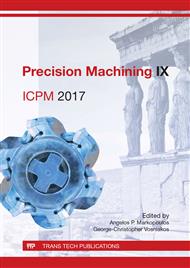[1]
O. Brandau, PDL Handbook Series Stretch. Blow Molding (2nd ed. ), Elsevier, (2012).
Google Scholar
[2]
M. Bordival, F.M. Schmidt, Y. Le Maoult, V. Velay, Optimization of preform temperature distribution for the stretch-blow molding of PET bottles: Infrared heating and blowing modeling. Polymer Engineering & Science, 1 (2008) 1023-1026.
DOI: 10.1002/pen.21296
Google Scholar
[3]
C.A.S. Miranda, J.J.D. Câmara, O.P. Monken and G.C. Dos Santos, Design Optimization and Weight Reduction of 500 mL CSD PET Bottle through FEM Simulations. Journal of Materials Science and Engineering, 1 (2011) 947-959.
Google Scholar
[4]
J.A.W.M. Groot, C.G. Giannopapa, R.M.M. Mattheij, CASA-Report 11-27: Modelling stretch blow moulding of polymer containers using level set methods. University of Eidhoven (2011, April). Retrieved from http: /www. win. tue. nl/ analysis/reports/rana11-27. pdf.
Google Scholar
[5]
B. Cosson, L. Chevalier, G. Régnier, Simulation of the stretch blow moulding process: from the modelling of the microstructure evolution to the end-use elastic properties of polyethylene terephthalate bottles. International Journal of Material Forming, Springer, 5(1) (2012).
DOI: 10.1007/s12289-010-1010-y
Google Scholar
[6]
E. Deloye, J. -M. Haudin, N. Billon, Influence of chemical architecture of PET on ability to stretch blow moulding. International Journal of Material Forming 1(1 Supplement) (2008) 715-718.
DOI: 10.1007/s12289-008-0315-6
Google Scholar
[7]
J. Zimmer, M. Stommel, Method for the evaluation of stretch blow molding simulations with free blow trials. IOP Conf. Series: Materials Science and Engineering, IOP Publishing, 48 (2013) 1-10.
DOI: 10.1088/1757-899x/48/1/012004
Google Scholar
[8]
J.A.W.M. Groot, R.M.M. Mattheij, C.G. Giannopapa, Modeling Preform and Mold Shapes in Blow Molding. Progress in Industrial Mathematics at ECMI 2010, Mathematics in Industry Springer, (2012) 319-326.
DOI: 10.1007/978-3-642-25100-9_37
Google Scholar
[9]
K.M. Au, K.M. Yu, Conformal cooling channel design and CAE simulation for rapid blow mold. The International Journal of Advanced Manufacturing Technology, Springer, 66(1-4) (2013) 311-324.
DOI: 10.1007/s00170-012-4326-6
Google Scholar
[10]
V.V. Stulov, Simulation of heat transfer on cooling molds. Journal of Machinery Manufacture and Reliability, Springer, 40(4) (2011) 366-371.
DOI: 10.3103/s1052618811030150
Google Scholar
[11]
J.C. Lin, C.C. Tai, Accuracy Optimization for Mold Surface Profile Milling. The International Journal of Advanced Manufacturing Technology, Springer, 15(1) (1999) 15-25.
DOI: 10.1007/s001700050034
Google Scholar
[12]
W.M. Chan, L. Yan, W. Xiang, B.T. Cheok, A 3D CAD knowledge-based assisted injection mold design system. The International Journal of Advanced Manufacturing Technology, Springer, 22(5-6) (2003) 387-395.
DOI: 10.1007/s00170-002-1514-9
Google Scholar
[13]
K.S. Chin, C.K. Mok, X. Zu, Modeling and performance simulation of mold-design process. The International Journal of Advanced Manufacturing Technology, Springer, 34(3-4) (2007) 236-251.
Google Scholar
[14]
K. GiridharReddy, K. Rajagopal, Blow Mould Tool Design and Manufacturing Process for 1litre Pet Bottle. IOSR Journal of Mechanical and Civil Engineering (IOSR-JMCE), 8(1) (2013) 12-21.
DOI: 10.9790/1684-0811221
Google Scholar
[15]
A. Fiorentino, Cost drivers-based method for machining and assembly cost estimations in mold manufacturing. The International Journal of Advanced Manufacturing Technology, Springer, 70(5-8) (2013) 1437-1444.
DOI: 10.1007/s00170-013-5419-6
Google Scholar
[16]
B. Denkena, J.T. Schürmeyer, R. Kaddour, V. Böß, Assessing mold costs analysing manufacturing processes of cavities. The International Journal of Advanced Manufacturing Technology, Springer, 56(9-12) (2011) 943-949.
DOI: 10.1007/s00170-011-3265-y
Google Scholar
[17]
Z. Bouaziz, J.B. Younes, A. Zghal, A Fast and Reliable Tool for Estimates for Plastic Blowing Molds. The International Journal of Advanced Manufacturing Technology, Springer, 20(7) (2002) 545-550.
DOI: 10.1007/s001700200188
Google Scholar


